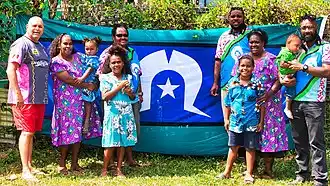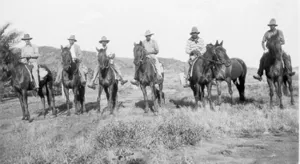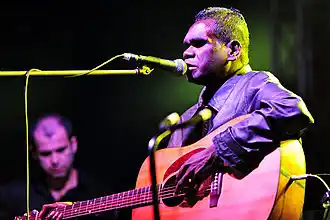Indigenous Australian (Aboriginal & Torres Strait Islander) surnames reflect the evolution of their identification and naming practices. In traditional Indigenous Australian societies individuals were typically known by different names throughout their lives. Various factors such as their “nation”, “mob”, “country”, age, status and relationships (spiritual, physical and personal) influenced these names and how they were interpreted by others in their community. The use of more formal, life-long names was governed by complex, and often restrictive, tribal rules. The use of Western-style names, including surnames, among Indigenous Australians is a direct result of European colonisation.
Important Notes:
- In some Aboriginal and Torres Strait Islander communities hearing recordings, seeing images, or reading the names of deceased persons may cause sadness or distress. They may also go against strongly held cultural prohibitions. Researchers are encouraged to be aware of this sensitivity.
- With an estimated 650 different languages spoken among Indigenous Australians at the time of white settlement it is not practical or generally helpful to provide specific surname examples in their original tongue.
Research your ancestors on MyHeritage
History of Indigenous AustraliansHistory of Indigenous Australians
A separate Wiki article on Australian Genealogy includes an overview of the migration of Aboriginal and Torres Strait Islanders to Australia at least 50,000 years ago and their historical experience both before and after the arrival of British colonisers in the late 18th century.

From the mid 20th century onwards official and popular attitudes became progressively more supportive of the Indigenous Australian political and land rights, their distinct cultures, flowing from a greater recognition of their painful post-colonial history[1].
With that change in attitudes more Australians have acknowledged their Indigenous Australian heritage. In recent decades the number of Australians identifying as Indigenous has greatly exceeded the rate of natural population increase, in part reflecting that Indigenous Australians derive their identity not just via bloodlines but from broader family kinship and acceptance by others in their community as one of their own[2].
Traditional Indigenous Australian identification and naming practicesTraditional Indigenous Australian identification and naming practices
Before colonisation (white settlement) Indigenous Australian people typically identified themselves by reference to their connection to "country" (traditional lands), language and the spiritual or kinship systems of their "nation" (tribe) or "mob" (clan). The use of specific names at different times was governed by detailed and complex rules. Within their community the use of a particular name at the wrong time, or in an inappropriate manner, could cause significant offense to the individual and their family[3].
Indigenous Australian identification included several types of names[4][5]:
- Skin names given at birth which indicated a person's bloodline and their relationships within the community.
- Birth names, given at birth but not generally used until the child was walking.
- Kalyartu relationship names, a specific type of kinship connection transmitted from grandparent to grandchild.
- Place-based names, often using suffixes like -nguru or -nguraru ("of the place").
- Descriptive names, especially used during times of bereavement.
- Nicknames (also known as "spoken names”), used to identify someone in everyday interactions without invoking their sacred or ceremonial name.
- Totem (spiritual) names, which linked a person to their physical environment and their specific responsibilities. Individuals typically had at least four such names: personal, family, mob and nation.
- Ceremonial names, given during important life events such as marriage, the birth of children, or at key ceremonial gatherings.
Post-colonisation naming practices affecting Indigenous AustraliansPost-colonisation naming practices affecting Indigenous Australians
Following the arrival of the British in the late 18th century naming practices were usually imposed on Indigenous Australians by European colonisers and administrators. The assignment of European surnames was part of a broader and deliberate process of cultural assimilation and administrative control.

Name assignment to Indigenous Australians generally fell into one of these categories[6]:
- Employer of Property surnames: Indigenous Australian people sometimes adopted or were assigned the surname of their European employer. This could be the employer’s surname itself or one derived from the name of the pastoral property on which they were born or worked[7].
- "Combination" names: Some surnames combined European names with other identifiers, such as Mickey Free or Cargara Jimmy.
- Expropriated European surnames: Examples include Weller, Gordon, Mileson, Brown, Chisholm, Douglas and Owen.
- Place names: Surnames based on locations such as Cargara, Callandoon, Grafton, Brisbane and Normanton.
- English literary or classical names: Some Indigenous Australian people were given surnames inspired by English literature or classical figures, such as Macbeth, Hamlet, Pickwick, Hector and Hannibal.
Challenges in researching Indigenous Australian namesChallenges in researching Indigenous Australian names
The website of the Australian Institute of Aboriginal and Torres Strait Islanders (AIATSIS) includes an excellent overview of the challenges of researching the names of Indigenous ancestors. These include:
- An individual may have been known by many different names over their lifetime.
- Names may have changed several times due to life events such as marriage, partnerships, adoption or fostering.
- It was common for Indigenous Australians to use, or be known by, variations of their formal birth names. The AIATSIS gives the example of someone called Vera Lillian at birth who may have been known as Lillian, Lily, Lilli, Lilly or Lillie at various times in her life.
- Some Indigenous Australians chose to change their names for various reasons, for example adopting an alias to avoid control by police or government agents.
- The same Indigenous name may be spelt in many different ways in colonial and administrative records.
- Sometimes the only names recorded in official papers are nicknames or joke names given to them by Europeans, for example, Little Jack, Old Mary and Billy Boy.
- Children sometimes used the surname of a step-father or other partner of their birth mother.
With these challenges in mind here are some tips for researching Indigenous Australian surnames:
- Consider every known name (both abbreviations and full) and their spelling variations:
- Allow for variations in how names were recorded, as they may have been written down by non-Aboriginal people.
- Be aware that in older records Indigenous Australians often included what today we would regard as offensive terms like ‘full blood’, ‘half-caste’, ‘quarter-caste’, ‘quadroon’, ‘octaroon’, which were used to indicate the perceived degree of Aboriginal bloodline heritage.
- In your own record-keeping decide on a consistent style for referencing the Indigenous Australian names of interest.
Celebrities with Indigenous Australian surnamesCelebrities with Indigenous Australian surnames

- Ash Barty (1996-) and Evonne Goolagong Cawley (1951-) former Grand Slam winning tennis players.
- Woollarawarre Bennelong, also known as Baneelon (1764-1813): Played a keyrole as a mediator between the Eora, the local Aboriginal nation and the British colonists in the first years of British settlement.
- Vincent Lingiari (1908-1988): Aboriginal rights activist.
- Eddie Mabo (1936-1992): Torres Strait Islander who was a pivotal figure in the successful campaign for the recognition of Indigenous land rights.
- Albert Namatjira, born Elea Namatjira (1902-1959): First Aboriginal painter to achieve widespread recognition and popularity.
- Oodgeroo Noonuccal, born as Kath Walker (1920-1993): Influential poet, black rights activist, educator and environmentalist.
- Pemulwuy (c1750-1802): Early Aboriginal resistance fighter against European colonisation.
- Jacinta Nampijinpa Price (1981-): Influential politician and Indigenous affairs advocate.
- Gurrumul Yunupingu (1971-2017): multi-award winning and internationally recognised musician, multi-instrumentalist and singer.
See alsoSee also
- Kanak surnames
- Australian surnames
- New Zealand surnames
- Australia
- Australian genealogy
- British surnames
- Māori surnames
- Hawaiian surnames
- Tongan surnames
- Polish surnames
- Afrikaans surnames
- Greek surnames
- Portuguese surnames
- Sephardic Jewish surnames
- Latvian surnames
- Lithuanian surnames
- Ashkenazi Jewish surnames
- Chinese surnames
- Alsatian surnames
- Indian surnames
- Scottish surnames
- Welsh surnames
- Canadian surnames
- Danish surnames
- American surnames
- Irish surnames
- French surnames
Explore more about Indigenous Australian surnamesExplore more about Indigenous Australian surnames
The are a range of Australian resources are available which can help you explore Indigenous Australian surnames:
The Australian Institute of Aboriginal and Torres Strait Islander Studies offers guides and resources, including a series of biographical indexes and dictionaries which contains names from publications about Indigenous Australians. They also have a native title research and access service and provide family history research assistance and access to information[8].
National Archives of Australia holds records about Aboriginal and Torres Strait Islander people, including the Bringing Them Home name index, which can help locate names in their records. The NAA also has a useful guide titled Aboriginal and Torres Strait Islander people in Commonwealth records. Note however that generally these records cannot be accessed directly online, rather you must complete an online application form.
Australian State and Territory Libraries, whose online presence can ber accessed from here, hold numerous sources for studies relating to Indigenous Australians, including kinship groups, tribes, clans, and linguistic groups. Search individual library online catalogues for terms like "aboriginal people-genealogy".
Additionally, there are MyHeritage family trees focused on specific Indigenous Australian surnames, for example:
- Discover people named Ganiup Aboriginal
- Discover people named Domjum Aboriginal
- Discover people named Kitty Aboriginal
- aboriginal Web Site
Other resources include:
- Facebook Live: Australian Resources on MyHeritage webinar on the MyHeritage Knowledge Base
- Dictionaries of Western Australians.
- Aboriginal Land Council records.
- Hunter Living Histories which provides access to several important research papers covering early contact with Indigenous Australians, most importantly Australian Reminiscences & Papers of L.E. Threlkeld Missionary to the Aborigines 1824 -1859.
References
- ↑ Aboriginal and Torres Strait Islander culture and history. VPSC. (2024, May 28).
- ↑ Korff, J. (2023, August 27). Aboriginal identity: Who is “aboriginal”? Creative Spirits.
- ↑ Wikimedia Foundation. (2025, January 17). Australian Aboriginal identity. Wikipedia.
- ↑ Hagen, R. (n.d.). Traditional Australian Aboriginal naming processes.
- ↑ Triffitt, G. (2007, April). Australian Aboriginal names. The Indexer.
- ↑ Australian Institute of Aboriginal and Torres Strait Islander Studies. (n.d.). Indigenous names. AIATSIS corporate website.
- ↑ Burke, H., & Murray, G. (2017, December 18). What’s in a name? Archaeology on the Frontier.
- ↑ Family history kit contents. (n.d.).

